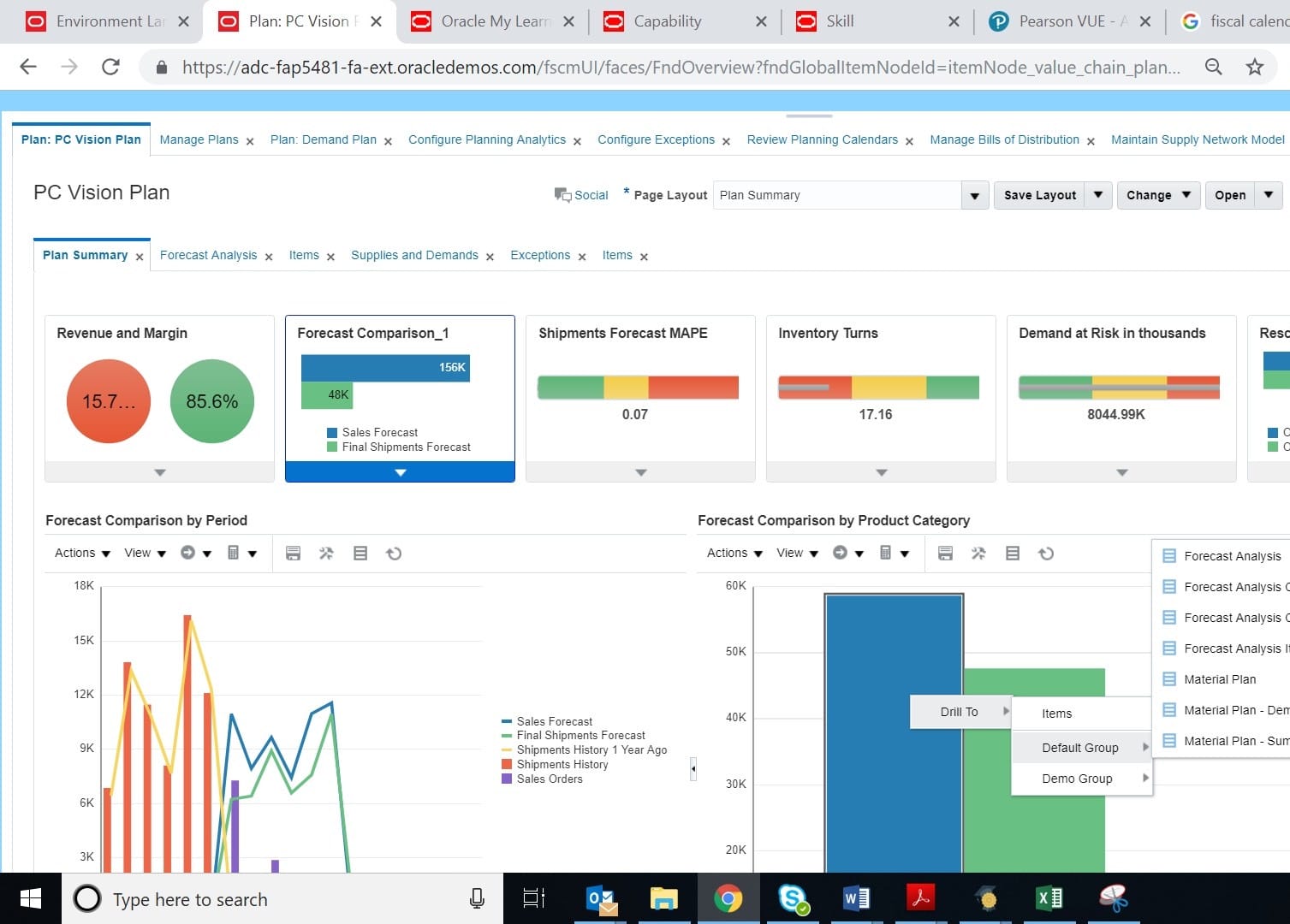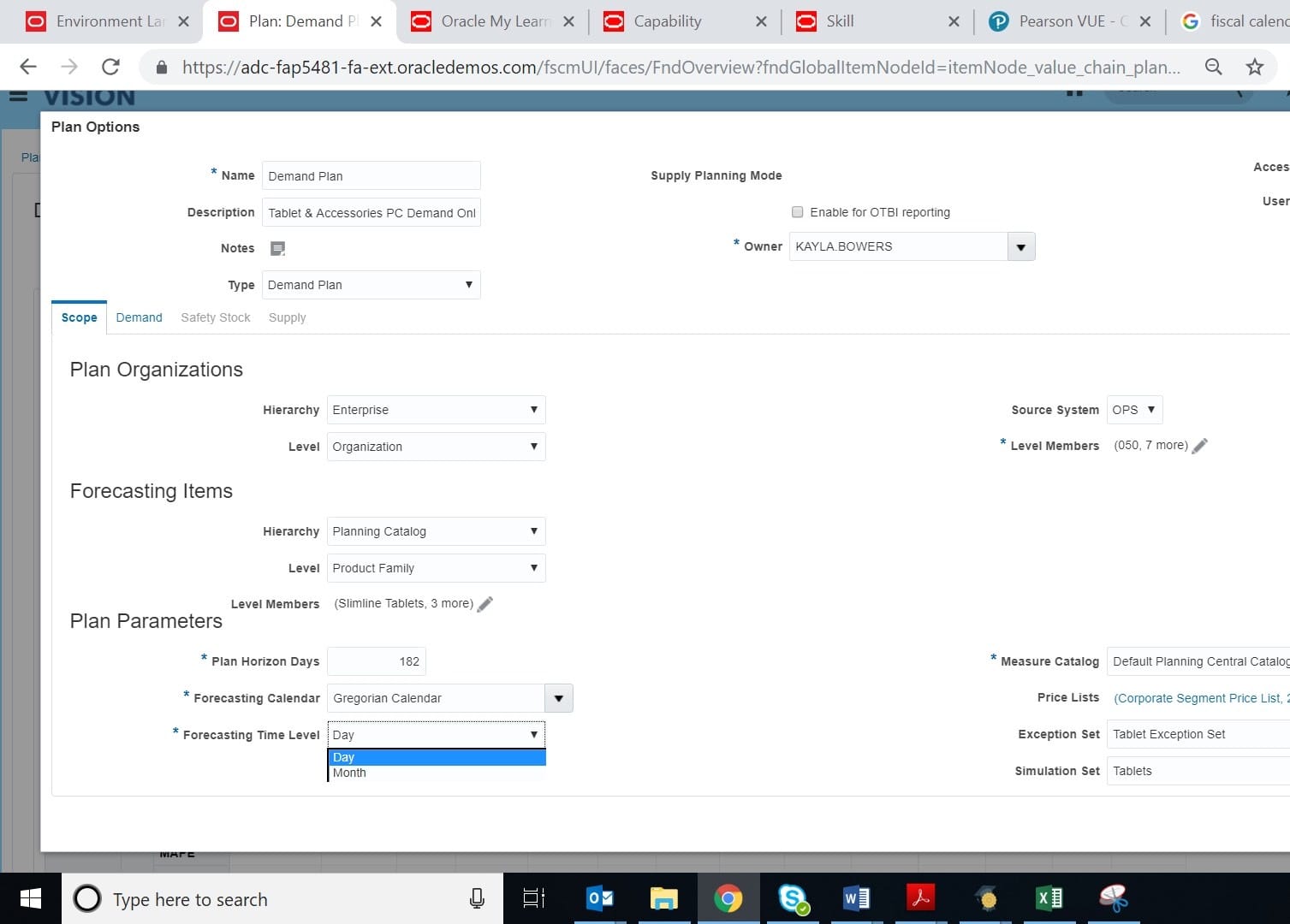Exam Details
Exam Code
:1Z0-1066-22Exam Name
:Oracle Planning and Collaboration Cloud 2022 Implementation ProfessionalCertification
:Oracle CertificationsVendor
:OracleTotal Questions
:109 Q&AsLast Updated
:Mar 26, 2025
Oracle Oracle Certifications 1Z0-1066-22 Questions & Answers
-
Question 21:

You have run a plan for your organization and there were sales orders that have been set up for drop shipment that you cannot see in the plan. Which two options explain why the sales orders cannot be seen in the plan? (Choose two.)
A. Drop Ship Item Validation Org has not been set up.
B. Drop Ship Demand Class has not be set up.
C. Supplier not configured in Manage Planning Source Systems
D. Include drop ship demands and supplies flag has not been checked on your plan options.
E. Planning Profile 'Enable Planning for Drop Shipments' has not been set to 'Yes'.
-
Question 22:
Demand planner opens the pre-seeded plan summary of the demand plan and wants to analyze the forecast results. Describe the steps to review and analyze the forecast results.
A. Click "Revenue and Margin" tile. Review the "Revenue by Period" graph and pick a specific period. Right-click on a period, click Drill To -> Default Group -> Revenue Analysis to open the table and review the details.
B. Click "Forecast Comparison in the thousands" tile. Review "Forecast Comparison by Product Category" graph and pick a product category. Right-click on product category, click Drill To -> Default Group -> Forecast Analysis to open the table and review the details.
C. Click "Revenue and Forecast" tile. Review "Revenue by Period" graph and pick a specific period. Right-click on a period, click Drill To -> Default Group -> Forecast Analysis to open the table and review the details.
D. Click "Demand at Risk in thousands" tile. Review "Demand at Risk by Product Category" graph and pick a product category. Right-click on product category, click Drill To -> Default Group -> Demand Analysis to open the table and review the details.
-
Question 23:
You analyzed your customer's shipment history data at item and organization level. You found that the customer has many new products with limited history.
Does Planning Central support forecasting products with limited history, and what is this process called?
A. No, Planning Central does not support the Croston Method for Sparse Demand forecasting method.
B. Yes, Planning Central supports the Regression for Sparse Demand forecasting method, typically used for new products.
C. Yes, Planning Central supports the Holt Exponential Smoothing forecasting method used for newly introduced products.
D. No, Planning Central does not support the Regression for Sparse Demand forecasting method.
E. No, Planning Central does not support the Holt Exponential Smoothing forecasting method.
-
Question 24:

You have created several infotiles based on the client requirements. You now want to group them together for display. How do you accomplish this?
A. First build them into an info set in Manage Infosets. Then open the info set on the plan by going to Open (choose area) > Choose info set.
B. No need to group them. Open them directly on the plan going to Open (choose area) > Choose Infotile.
C. First build them into a tile set in Manage Table, Graphs, and Analysis Sets. Then open the tile set on the plan by going to Open (choose area) > Choose tile set.
D. First build them into a planning group in Manage Planning Groups. Then open the planning group on the plan by going to Open (choose area) > Choose planning group.
E. First build them into a planning measure in Manage Planning Measures. Then open the planning measure on the plan by going to Open (choose area) > Choose planning measure.
-
Question 25:
Which calendar is supported in the supply planning process but does not support bucketing by week?
A. Lunisolar
B. Fiscal
C. Roman
D. Gregorian
E. Julian
-
Question 26:
You are a demand planner and you want to generate forecast for all laptop and desktop products in the US business unit. You are using standard enterprise and product hierarchy. You have created a demand plan and now you must define plan scope.
Identify three valid steps. (Choose three.)
A. For plan parameters, select forecasting calendar as Gregorian and time level as week.
B. For forecasting items, select hierarchy as product, level as category level 1, and laptop and desktop categories as level members.
C. For plan parameters, select forecasting calendar as Gregorian and time level as month.
D. For plan organizations, select hierarchy as enterprise, level as country, and US as level member.
E. For forecasting items, select hierarchy as product, level as product, and all laptop and desktop products as level members.
F. For plan organizations, select hierarchy as enterprise, level as business unit, and US and level member.
-
Question 27:
A customer has created a supply plan based on current requirement. Due to changes in third party forecast, the plan must be rerun with these recent updates. However, while this new information became available, existing supply like on-hand inventory and work order completions have also been updated.
Which data refresh option should be used to reflect all these changes in the plan?
A. Do not refresh with current data
B. Refresh with quick refresh option
C. Refresh with forecast data
D. Refresh with selected current data
E. Refresh with current data
-
Question 28:
As a new planner, you want to test simulation set functionality. You have created a simulation set named 'Test Simulation Set.' In this simulation set, you have already added Item 98573. You would like to change the item specification 'Fixed Order Quantity' to 10 within this simulation set.
Which sequence will allow you to accomplish this task?
A. Select and open 'Test Simulation Set' > Search and select Item 98573 > Highlight item > Select 'Action' > Select 'Edit' > Find Fixed Order Quantity specification> under the 'Action' column select 'set value as' > under the 'Value' column enter 10
B. Select and open 'Test Simulation Set' > Search and select Item 98573 > Highlight item > Select 'View' > Select 'Columns' > Check box next to Fixed Order Quantity specification> the 'Fixed Order Quantity' will now show on the Item 98573 line > Highlight line for Item 98573 and scroll right until you find 'Fixed Order Quantity' > Change value to 10
C. Select and open 'Test Simulation Set' > Search and select Item 98573 > Highlight item > Select 'Action' > Select 'Edit' > Find Fixed Order Quantity specification> under the 'Action' column select 'reset to original' > under the 'Value' column enter 10
D. Select and open 'Test Simulation Set' > Search and select Item 98573 > Highlight line for Item 98573 and scroll right until you find 'Fixed Order Quantity' > Change value to 10
-
Question 29:
Which disaggregation methods are used for each of these measures: adjusted shipments forecast, target service level, and shipments forecast?
A. Adjusted shipments forecast uses measure, target service level uses same value, and shipments forecast uses self.
B. Adjusted shipments forecast uses proportional, target service level uses same value, and shipments forecast uses measure.
C. Adjusted shipments forecast uses measure, target service level uses same value, and shipments forecast doesn't have any disaggregation method.
D. Adjusted shipments forecast uses measure, target service level uses equal, and shipments forecast doesn't have any disaggregation method.
E. Adjusted shipments forecast uses equal, target service level uses same value, and shipments forecast uses measure.
-
Question 30:
Which is the proper fulfillment strategy to plan for supply using the appropriate lead times required for processing material at a third party, based on the manufacturing work definition?
A. outside processing operations
B. expense destination transfers
C. contract manufacturing
D. back-to-back orders
E. drop shipments
Related Exams:
1Z0-020
Oracle8i: New Features for Administrators1Z0-023
Architecture and Administration1Z0-024
Performance Tuning1Z0-025
Backup and Recovery1Z0-026
Network Administration1Z0-034
Upgrade Oracle9i/10g OCA to Oracle Database OCP1Z0-036
Managing Oracle9i on Linux1Z0-041
Oracle Database 10g: DBA Assessment1Z0-052
Oracle Database 11g: Administration Workshop I1Z0-053
Oracle Database 11g: Administration II
Tips on How to Prepare for the Exams
Nowadays, the certification exams become more and more important and required by more and more enterprises when applying for a job. But how to prepare for the exam effectively? How to prepare for the exam in a short time with less efforts? How to get a ideal result and how to find the most reliable resources? Here on Vcedump.com, you will find all the answers. Vcedump.com provide not only Oracle exam questions, answers and explanations but also complete assistance on your exam preparation and certification application. If you are confused on your 1Z0-1066-22 exam preparations and Oracle certification application, do not hesitate to visit our Vcedump.com to find your solutions here.
